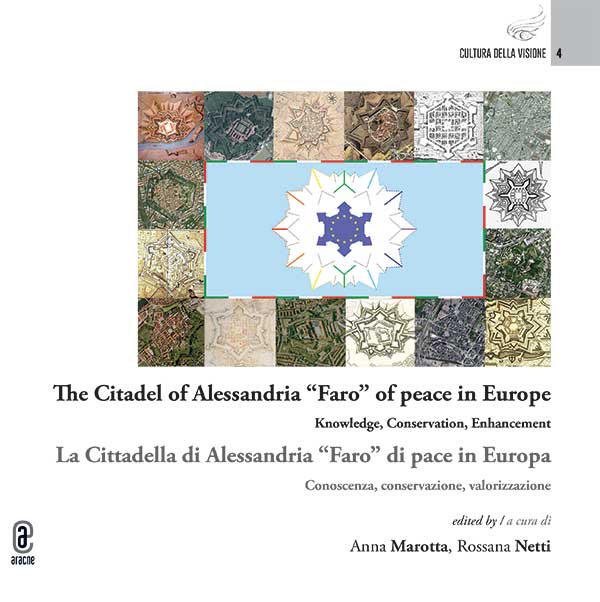DOI: 10.53136/979122181076921
Pagine: 293-300
Data di pubblicazione: Dicembre 2023
Editore: Aracne
SSD:
ICAR/19
The birds eye view “photographs” a clear distinction between Alessandria and the citadel, amplified by the presence of the river. For the vast majority of the 20th century and earlier, this “physical” separation reverberated in both the civil and military spheres, and in the different properties and competent authorities, which managed the city’s destiny independently. So, two identities co-existing, not too far from one other geographically, but fully separate and often in conflict. The citadel rose “from the ashes” of a neighbourhood of the city touching both banks of the Tanaro river. Designed by Bertola in 1728, the citadel removed a part of the urban nucleus, immediately positioning itself in a conflictual relationship with the civil city, which had been “mutilated” and forced to undergo specific restructuring. The citadel lived in function of the city and the river: it owed its position to the city, while also being completely detached from it and pushed out of it. In the second half of the 18th century, this physical and functional division remains: the citadel watches over the city and a much wider territory: it defends the borders of the kingdom to the south-west and it represents the bridgehead of the peninsula (this is how Napoleon interprets it much later). Military papers focus extensively on the stronghold and the ramparts (they do not speak of the city’s urban fabric); civil papers exclusively present the citadel as an encumbrance. It is during the Napoleonic era that the relationship between the city and citadel is revisited and reviewed: the citadel, deemed strategic, is enhanced, and Napoleon’s dream of “creating” a single, huge stronghold which combines city and citadel is pursued. Alessandria was founded is close conjunction with the Tanaro river (and the not-so-distant Bormida river). It is built around the waterways, exploiting its commercial and proto-industrial potential. For centuries, the river connects the neighbourhoods of Rovereto and Borgoglio; however, when the latter disappears due to the construction of Savoy citadel, these two banks become more and more distant, much more than the Tanaro riverbed is wide. Since its foundation in 1168, Alessandria is a city of water and canals: the Tanaro provides the water provision, but it is even more important for defensive, transportation and production purposes, as attested by the 28 watermills located along the city. As Alessandria’s natives know well, the river − seen as an ally − can often turn into a terrible enemy: the unstable flow of the water is subject to frequent and disastrous overflowing. During the modern era, the city is represented by many engineers and cartographers as still being in close relation with the river, and the connection with the “hamlet”, the covered bridge, appears to be highly important for city life. The city in the 17th century, when under Spanish influence, is depicted well in the map drawn by Giovanni Pietro Pelucco in 1625: the covered bridge connects the neighbourhoods either side of the Tanaro, creating a necessary passage for people moving through the gate of Asti, in Borgoglio, and Marengo, near the 16th-century citadel towards Tortona. The two nuclei are both fortified to the modern one, with bastions added to the medieval − and now greatly anachronistic − walls. The bastioned circuit, forcefully split into two, actually represents a criticality for the purposes of a correct defence: the river, which are the time was navigable, could easily become an access route for enemies. The Borgoglio neighbourhood, if not adequately defended, could fall into the hands of the enemy and be turned into an alarming bridgehead against Alessandria. Military engineers (including Fratino, Busca and Berretta) − on the Spaniards’ pay roll since the mid 16th century and for all the following century – debated how to solve the problem. They planned to amend the Borgoglio perimeter reducing its size and strengthening the bastions and external works. It is worth mentioning that the project which was started at the end of the 16th century and was resumed in 1604 foresaw the construction of a (pentagonal) citadel towards the city, on the bank opposite the current one; this highlighted the fact that, for Alessandria, the river is a natural defence, but that also defending oneself from the river is essential. At the end of the 17th century, the city is one, even if divided by the river: the two nuclei need to co-exist and there is no single project that does not foresee the cooperation of the two from a logistical and strategic-military perspective. This dramatically changes with Victor Amadeus II Duke of Savoy’s decision to build Bertola’s citadel: this transformation − explored both in terms of the genesis of the fortified structure and in terms of irremediably mutilating the city − is key to understanding the divisive relationship between these two disparate entities. In just a few years, Alessandria finds itself having to manage a difficult “loss”: its inhabitants are forced to find a new home, the poor having to relocate to the countryside and only the rich living within the walled city beyond the Tanaro river. The need to rebuild the architectural wealth (palazzos and churches were often not demolished, but completely transformed and reformed) lost due to Bertola’s project, turns the city into a construction site, irremediably transforming the city. Throughout the 18th century, the city’s urban fabric undergoes constant and profound change; noble families and brotherhoods search for new spaces in which to build palazzos and churches. In all likelihood, had it not been for the construction of the citadel in 1728, the urban restructuring of Alessandria would not have been so decisive in the subsequent decades. At that time, civil activities do not fully cease in old Borgoglio, which impacts on some project choices within the new citadel. It is during the second half of the 18th century − and then definitively with the Napoleonic occupation − that the military use of Borgoglio (rather than just the river itself) divides Alessandria from the stronghold. From the perspective of bureaucracy and daily life, the city and the citadel live separately: civil citizens must respond to the municipality; the citadel must obey rigid military rule; it is a territorial bastion designed to preserve the entire Kingdom of Sardinia (at least the continental portion) from potential or avoidable attacks. The distinction between the two spaces becomes even starker: it is a physical distance given the presence of the river, exasperated by the two fortified perimeters with their related external works which only add to indelibly marking the distance between the two, noticeable to this day. It is also a conceptual disunion: there is now permeability between the functions and the respective inhabitants. The soldiers, when off duty, explore the roads of the city; the Alessandrian locals, however, are not allowed similar access to the citadel. There is also an administrative schism − different managements and different rules − and the Renaissance era only contributes to exasperating such separation. Even in the papers, the “dismemberment” appears to be evident: the military blueprints focus on the citadel and urban walls, omitting the fabric and individual buildings of the civil city. The administrative papers, which focus on tax collection or management, do not go beyond the Tanaro, due to military secrecy and different competences. After the Napoleonic period, which will be discussed below, there is a (never completed) project which tries to reconnect the city and the citadel, creating a single military sphere; however, the separation is maintained for the entire 19th century and beyond, when Alessandria is still strongly permeated by military functions. The entire 20th century is characterised by a sort of inaccessibility to the citadel, seen by the Alessandrian themselves as a prohibited area, somewhat unknown and definitely undervalued. The 1994 flooding, the demolition of the bridge, the complete dismissal on behalf of the Armed Forces, and the construction of the Meier bridge8 defined the latter part of the century and the beginning of the new one: the controversies related to the project methods and choices cannot obscure the fact that the new bridge − with its large space dedicated to pedestrians − and the opening of the citadel to the public − which had exited military management − had given the citizens back a part of the city, albeit in an exceptional way considering shapes, sizes and possible uses. The architectural heritage is still unknown and undervalued, fragile if used in a disrespectful and inappropriate way.


